St Kliment University: Macroeconomics II - France's 2021 Economy
VerifiedAdded on 2021/06/14
|11
|3263
|124
Report
AI Summary
This report provides an in-depth analysis of the three most critical economic issues confronting France in 2021: foreign trade, unemployment, and rising inequalities. It begins by examining the impact of the COVID-19 pandemic on France's foreign trade, highlighting the decline in exports and impo...
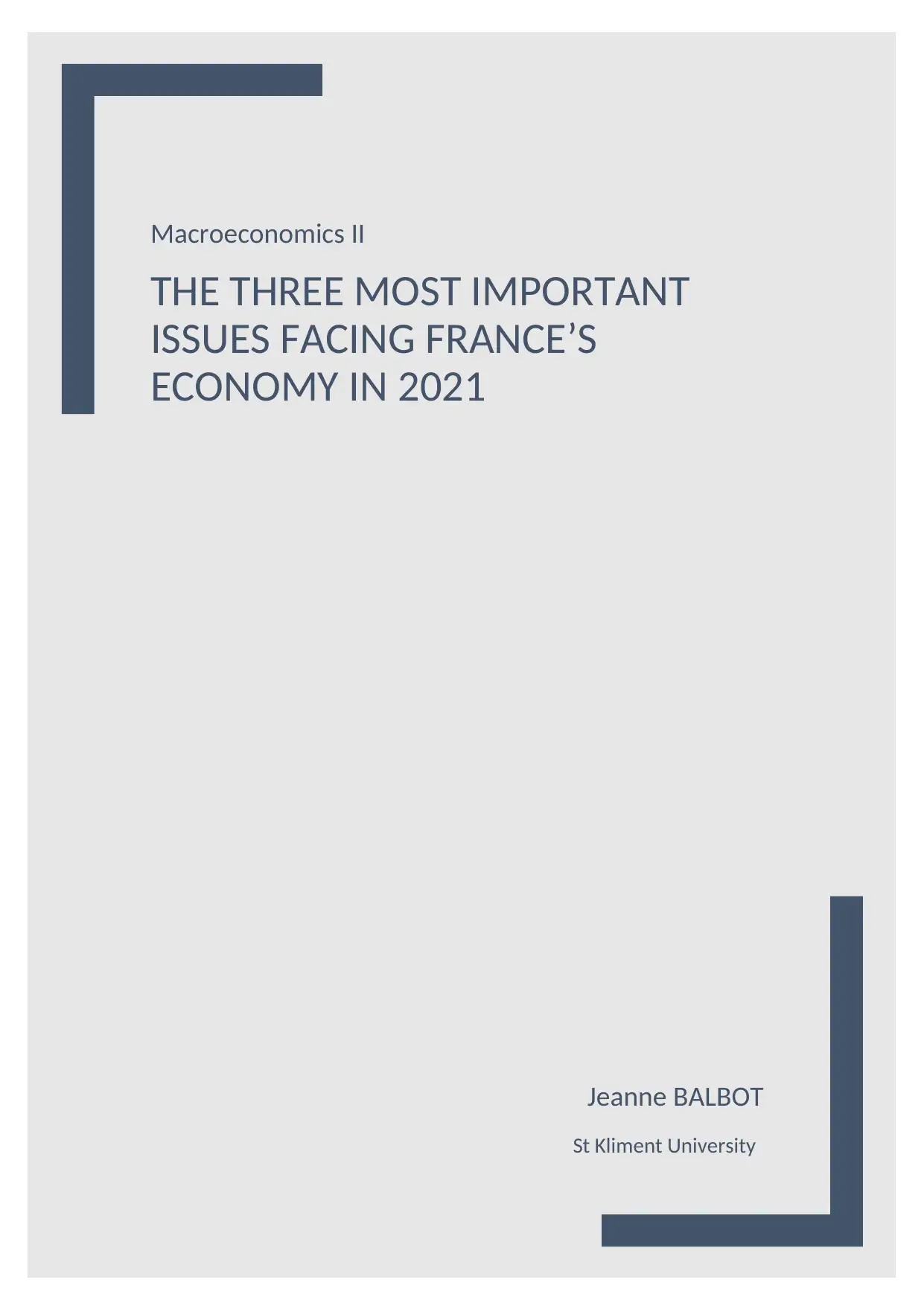
Macroeconomics II
THE THREE MOST IMPORTANT
ISSUES FACING FRANCE’S
ECONOMY IN 2021
Jeanne BALBOT
St Kliment University
THE THREE MOST IMPORTANT
ISSUES FACING FRANCE’S
ECONOMY IN 2021
Jeanne BALBOT
St Kliment University
Paraphrase This Document
Need a fresh take? Get an instant paraphrase of this document with our AI Paraphraser
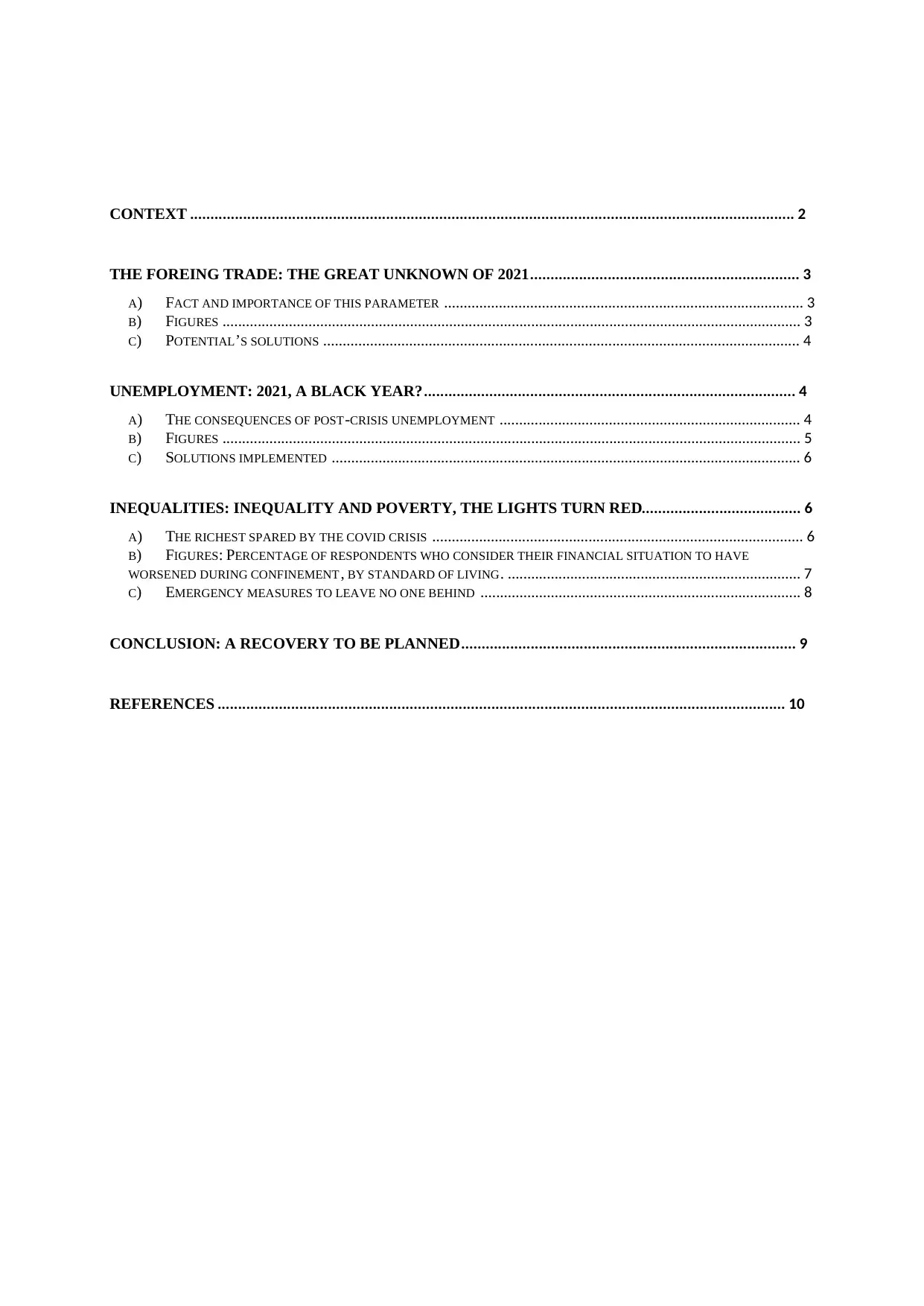
CONTEXT .................................................................................................................................................... 2
THE FOREING TRADE: THE GREAT UNKNOWN OF 2021 .................................................................. 3
A) FACT AND IMPORTANCE OF THIS PARAMETER ............................................................................................ 3
B) FIGURES .................................................................................................................................................... 3
C) POTENTIAL’S SOLUTIONS .......................................................................................................................... 4
UNEMPLOYMENT: 2021, A BLACK YEAR? ........................................................................................... 4
A) THE CONSEQUENCES OF POST-CRISIS UNEMPLOYMENT ............................................................................. 4
B) FIGURES .................................................................................................................................................... 5
C) SOLUTIONS IMPLEMENTED ........................................................................................................................ 6
INEQUALITIES: INEQUALITY AND POVERTY, THE LIGHTS TURN RED....................................... 6
A) THE RICHEST SPARED BY THE COVID CRISIS ............................................................................................... 6
B) FIGURES: PERCENTAGE OF RESPONDENTS WHO CONSIDER THEIR FINANCIAL SITUATION TO HAVE
WORSENED DURING CONFINEMENT , BY STANDARD OF LIVING. ........................................................................... 7
C) EMERGENCY MEASURES TO LEAVE NO ONE BEHIND .................................................................................. 8
CONCLUSION: A RECOVERY TO BE PLANNED .................................................................................. 9
REFERENCES ........................................................................................................................................... 10
THE FOREING TRADE: THE GREAT UNKNOWN OF 2021 .................................................................. 3
A) FACT AND IMPORTANCE OF THIS PARAMETER ............................................................................................ 3
B) FIGURES .................................................................................................................................................... 3
C) POTENTIAL’S SOLUTIONS .......................................................................................................................... 4
UNEMPLOYMENT: 2021, A BLACK YEAR? ........................................................................................... 4
A) THE CONSEQUENCES OF POST-CRISIS UNEMPLOYMENT ............................................................................. 4
B) FIGURES .................................................................................................................................................... 5
C) SOLUTIONS IMPLEMENTED ........................................................................................................................ 6
INEQUALITIES: INEQUALITY AND POVERTY, THE LIGHTS TURN RED....................................... 6
A) THE RICHEST SPARED BY THE COVID CRISIS ............................................................................................... 6
B) FIGURES: PERCENTAGE OF RESPONDENTS WHO CONSIDER THEIR FINANCIAL SITUATION TO HAVE
WORSENED DURING CONFINEMENT , BY STANDARD OF LIVING. ........................................................................... 7
C) EMERGENCY MEASURES TO LEAVE NO ONE BEHIND .................................................................................. 8
CONCLUSION: A RECOVERY TO BE PLANNED .................................................................................. 9
REFERENCES ........................................................................................................................................... 10
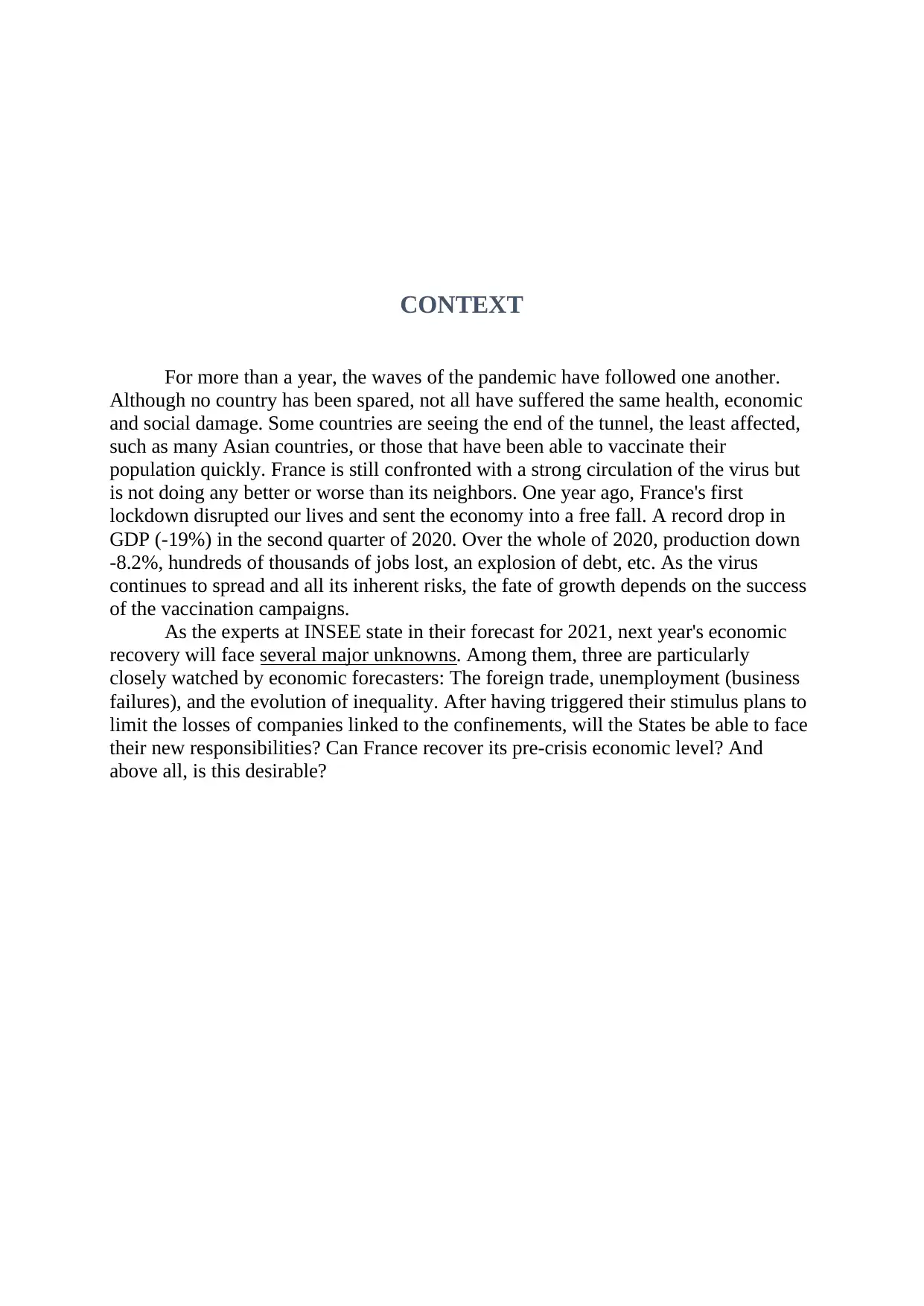
CONTEXT
For more than a year, the waves of the pandemic have followed one another.
Although no country has been spared, not all have suffered the same health, economic
and social damage. Some countries are seeing the end of the tunnel, the least affected,
such as many Asian countries, or those that have been able to vaccinate their
population quickly. France is still confronted with a strong circulation of the virus but
is not doing any better or worse than its neighbors. One year ago, France's first
lockdown disrupted our lives and sent the economy into a free fall. A record drop in
GDP (-19%) in the second quarter of 2020. Over the whole of 2020, production down
-8.2%, hundreds of thousands of jobs lost, an explosion of debt, etc. As the virus
continues to spread and all its inherent risks, the fate of growth depends on the success
of the vaccination campaigns.
As the experts at INSEE state in their forecast for 2021, next year's economic
recovery will face several major unknowns. Among them, three are particularly
closely watched by economic forecasters: The foreign trade, unemployment (business
failures), and the evolution of inequality. After having triggered their stimulus plans to
limit the losses of companies linked to the confinements, will the States be able to face
their new responsibilities? Can France recover its pre-crisis economic level? And
above all, is this desirable?
For more than a year, the waves of the pandemic have followed one another.
Although no country has been spared, not all have suffered the same health, economic
and social damage. Some countries are seeing the end of the tunnel, the least affected,
such as many Asian countries, or those that have been able to vaccinate their
population quickly. France is still confronted with a strong circulation of the virus but
is not doing any better or worse than its neighbors. One year ago, France's first
lockdown disrupted our lives and sent the economy into a free fall. A record drop in
GDP (-19%) in the second quarter of 2020. Over the whole of 2020, production down
-8.2%, hundreds of thousands of jobs lost, an explosion of debt, etc. As the virus
continues to spread and all its inherent risks, the fate of growth depends on the success
of the vaccination campaigns.
As the experts at INSEE state in their forecast for 2021, next year's economic
recovery will face several major unknowns. Among them, three are particularly
closely watched by economic forecasters: The foreign trade, unemployment (business
failures), and the evolution of inequality. After having triggered their stimulus plans to
limit the losses of companies linked to the confinements, will the States be able to face
their new responsibilities? Can France recover its pre-crisis economic level? And
above all, is this desirable?
⊘ This is a preview!⊘
Do you want full access?
Subscribe today to unlock all pages.

Trusted by 1+ million students worldwide
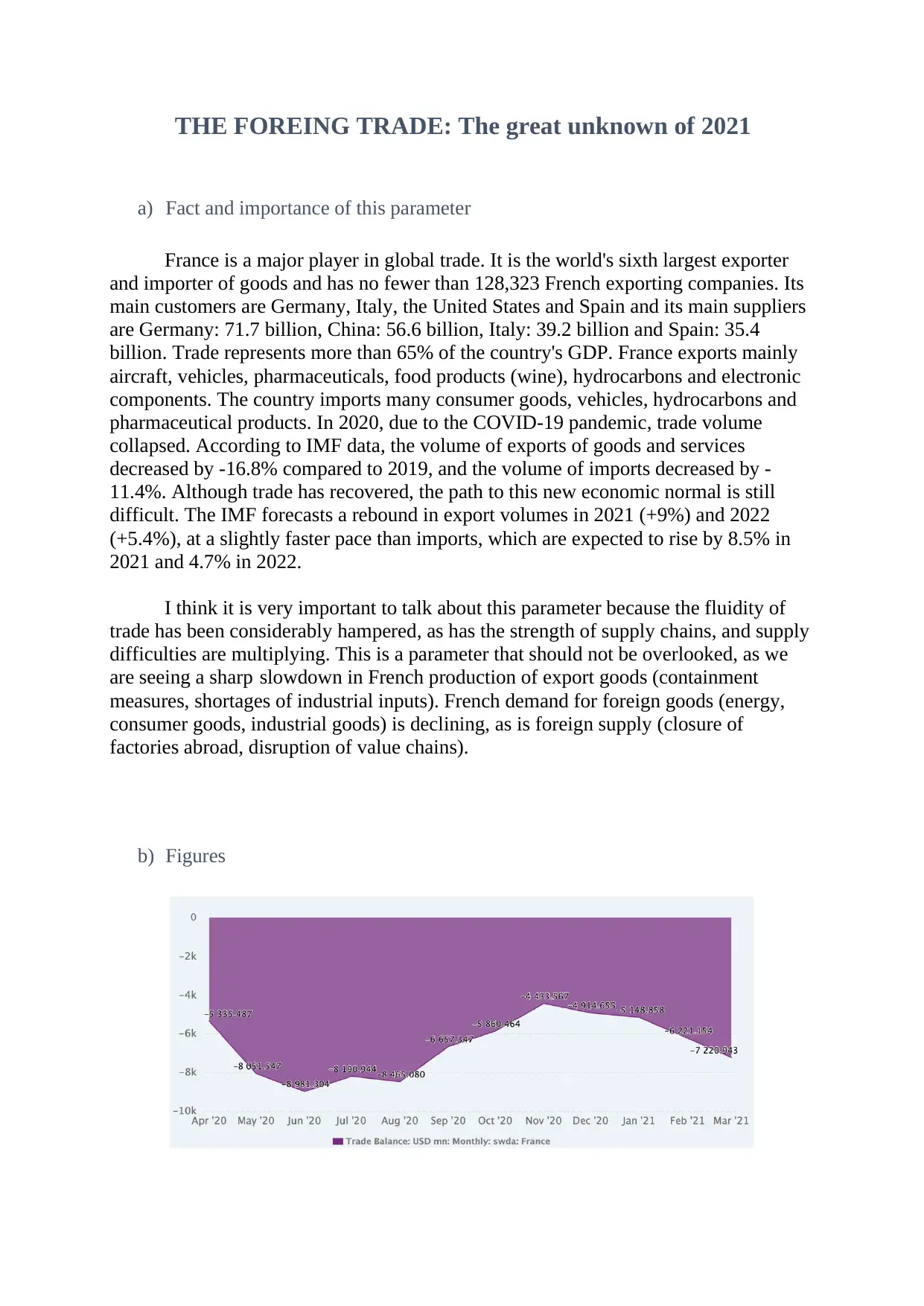
THE FOREING TRADE: The great unknown of 2021
a) Fact and importance of this parameter
France is a major player in global trade. It is the world's sixth largest exporter
and importer of goods and has no fewer than 128,323 French exporting companies. Its
main customers are Germany, Italy, the United States and Spain and its main suppliers
are Germany: 71.7 billion, China: 56.6 billion, Italy: 39.2 billion and Spain: 35.4
billion. Trade represents more than 65% of the country's GDP. France exports mainly
aircraft, vehicles, pharmaceuticals, food products (wine), hydrocarbons and electronic
components. The country imports many consumer goods, vehicles, hydrocarbons and
pharmaceutical products. In 2020, due to the COVID-19 pandemic, trade volume
collapsed. According to IMF data, the volume of exports of goods and services
decreased by -16.8% compared to 2019, and the volume of imports decreased by -
11.4%. Although trade has recovered, the path to this new economic normal is still
difficult. The IMF forecasts a rebound in export volumes in 2021 (+9%) and 2022
(+5.4%), at a slightly faster pace than imports, which are expected to rise by 8.5% in
2021 and 4.7% in 2022.
I think it is very important to talk about this parameter because the fluidity of
trade has been considerably hampered, as has the strength of supply chains, and supply
difficulties are multiplying. This is a parameter that should not be overlooked, as we
are seeing a sharp slowdown in French production of export goods (containment
measures, shortages of industrial inputs). French demand for foreign goods (energy,
consumer goods, industrial goods) is declining, as is foreign supply (closure of
factories abroad, disruption of value chains).
b) Figures
a) Fact and importance of this parameter
France is a major player in global trade. It is the world's sixth largest exporter
and importer of goods and has no fewer than 128,323 French exporting companies. Its
main customers are Germany, Italy, the United States and Spain and its main suppliers
are Germany: 71.7 billion, China: 56.6 billion, Italy: 39.2 billion and Spain: 35.4
billion. Trade represents more than 65% of the country's GDP. France exports mainly
aircraft, vehicles, pharmaceuticals, food products (wine), hydrocarbons and electronic
components. The country imports many consumer goods, vehicles, hydrocarbons and
pharmaceutical products. In 2020, due to the COVID-19 pandemic, trade volume
collapsed. According to IMF data, the volume of exports of goods and services
decreased by -16.8% compared to 2019, and the volume of imports decreased by -
11.4%. Although trade has recovered, the path to this new economic normal is still
difficult. The IMF forecasts a rebound in export volumes in 2021 (+9%) and 2022
(+5.4%), at a slightly faster pace than imports, which are expected to rise by 8.5% in
2021 and 4.7% in 2022.
I think it is very important to talk about this parameter because the fluidity of
trade has been considerably hampered, as has the strength of supply chains, and supply
difficulties are multiplying. This is a parameter that should not be overlooked, as we
are seeing a sharp slowdown in French production of export goods (containment
measures, shortages of industrial inputs). French demand for foreign goods (energy,
consumer goods, industrial goods) is declining, as is foreign supply (closure of
factories abroad, disruption of value chains).
b) Figures
Paraphrase This Document
Need a fresh take? Get an instant paraphrase of this document with our AI Paraphraser
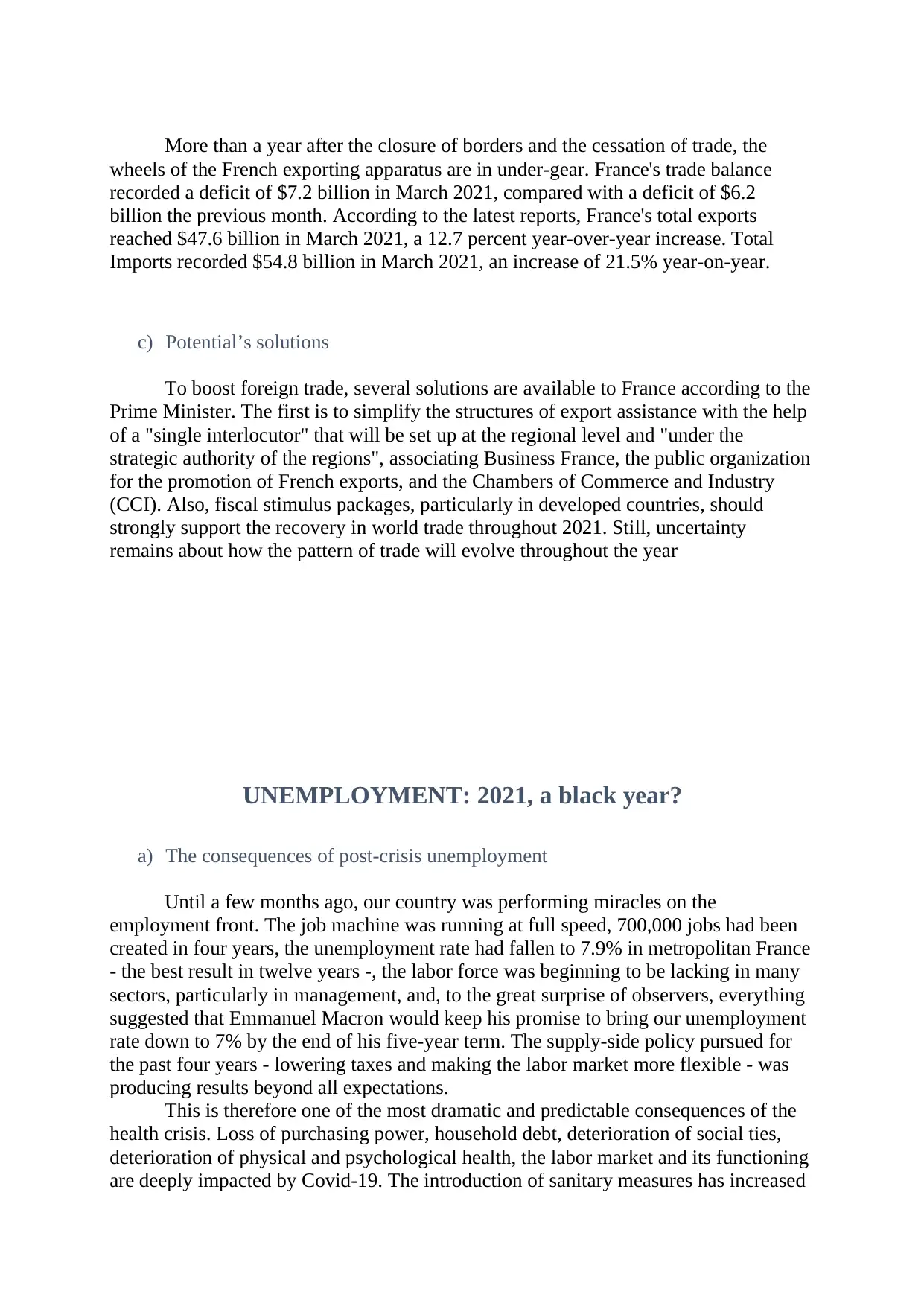
More than a year after the closure of borders and the cessation of trade, the
wheels of the French exporting apparatus are in under-gear. France's trade balance
recorded a deficit of $7.2 billion in March 2021, compared with a deficit of $6.2
billion the previous month. According to the latest reports, France's total exports
reached $47.6 billion in March 2021, a 12.7 percent year-over-year increase. Total
Imports recorded $54.8 billion in March 2021, an increase of 21.5% year-on-year.
c) Potential’s solutions
To boost foreign trade, several solutions are available to France according to the
Prime Minister. The first is to simplify the structures of export assistance with the help
of a "single interlocutor" that will be set up at the regional level and "under the
strategic authority of the regions", associating Business France, the public organization
for the promotion of French exports, and the Chambers of Commerce and Industry
(CCI). Also, fiscal stimulus packages, particularly in developed countries, should
strongly support the recovery in world trade throughout 2021. Still, uncertainty
remains about how the pattern of trade will evolve throughout the year
UNEMPLOYMENT: 2021, a black year?
a) The consequences of post-crisis unemployment
Until a few months ago, our country was performing miracles on the
employment front. The job machine was running at full speed, 700,000 jobs had been
created in four years, the unemployment rate had fallen to 7.9% in metropolitan France
- the best result in twelve years -, the labor force was beginning to be lacking in many
sectors, particularly in management, and, to the great surprise of observers, everything
suggested that Emmanuel Macron would keep his promise to bring our unemployment
rate down to 7% by the end of his five-year term. The supply-side policy pursued for
the past four years - lowering taxes and making the labor market more flexible - was
producing results beyond all expectations.
This is therefore one of the most dramatic and predictable consequences of the
health crisis. Loss of purchasing power, household debt, deterioration of social ties,
deterioration of physical and psychological health, the labor market and its functioning
are deeply impacted by Covid-19. The introduction of sanitary measures has increased
wheels of the French exporting apparatus are in under-gear. France's trade balance
recorded a deficit of $7.2 billion in March 2021, compared with a deficit of $6.2
billion the previous month. According to the latest reports, France's total exports
reached $47.6 billion in March 2021, a 12.7 percent year-over-year increase. Total
Imports recorded $54.8 billion in March 2021, an increase of 21.5% year-on-year.
c) Potential’s solutions
To boost foreign trade, several solutions are available to France according to the
Prime Minister. The first is to simplify the structures of export assistance with the help
of a "single interlocutor" that will be set up at the regional level and "under the
strategic authority of the regions", associating Business France, the public organization
for the promotion of French exports, and the Chambers of Commerce and Industry
(CCI). Also, fiscal stimulus packages, particularly in developed countries, should
strongly support the recovery in world trade throughout 2021. Still, uncertainty
remains about how the pattern of trade will evolve throughout the year
UNEMPLOYMENT: 2021, a black year?
a) The consequences of post-crisis unemployment
Until a few months ago, our country was performing miracles on the
employment front. The job machine was running at full speed, 700,000 jobs had been
created in four years, the unemployment rate had fallen to 7.9% in metropolitan France
- the best result in twelve years -, the labor force was beginning to be lacking in many
sectors, particularly in management, and, to the great surprise of observers, everything
suggested that Emmanuel Macron would keep his promise to bring our unemployment
rate down to 7% by the end of his five-year term. The supply-side policy pursued for
the past four years - lowering taxes and making the labor market more flexible - was
producing results beyond all expectations.
This is therefore one of the most dramatic and predictable consequences of the
health crisis. Loss of purchasing power, household debt, deterioration of social ties,
deterioration of physical and psychological health, the labor market and its functioning
are deeply impacted by Covid-19. The introduction of sanitary measures has increased
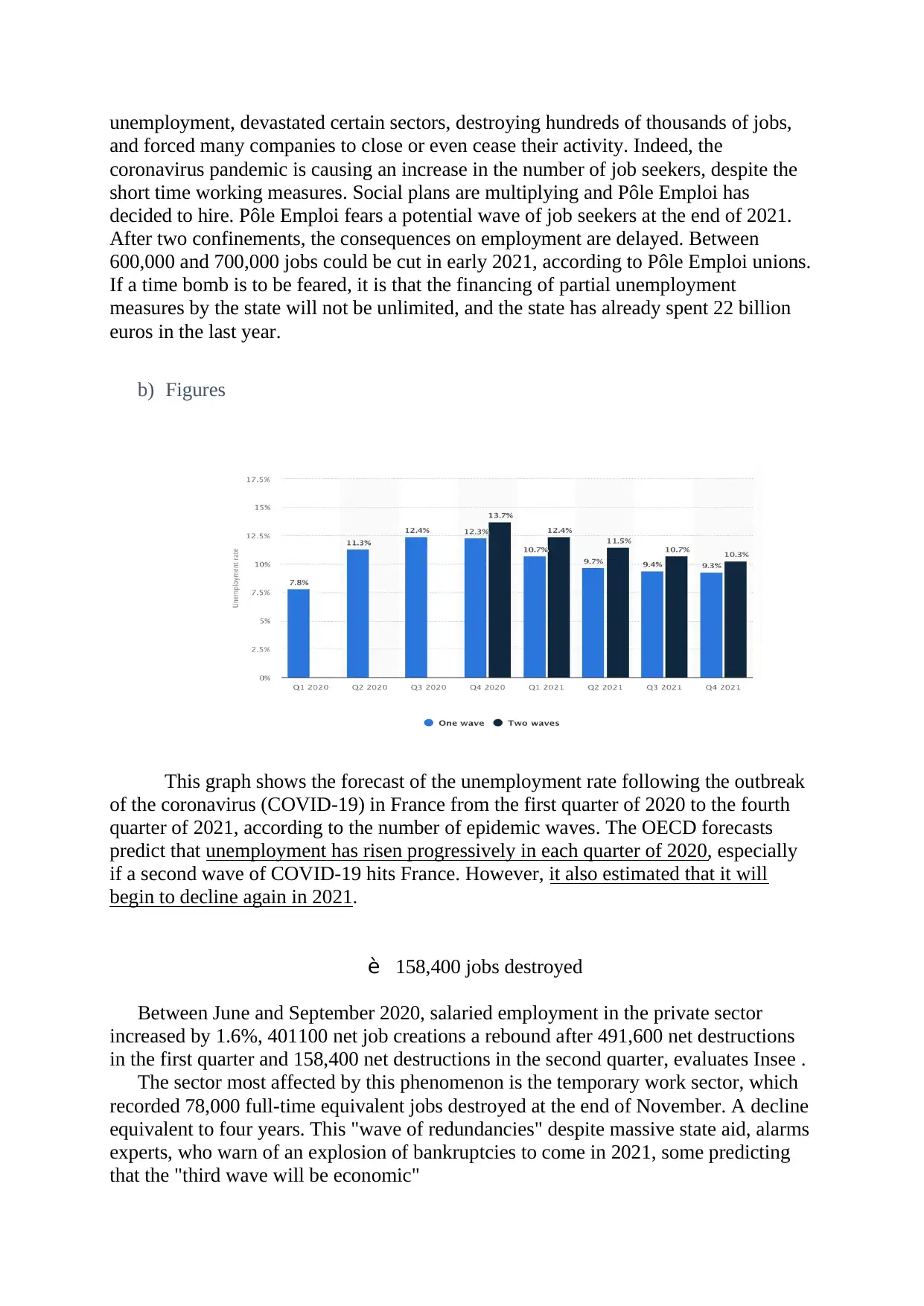
unemployment, devastated certain sectors, destroying hundreds of thousands of jobs,
and forced many companies to close or even cease their activity. Indeed, the
coronavirus pandemic is causing an increase in the number of job seekers, despite the
short time working measures. Social plans are multiplying and Pôle Emploi has
decided to hire. Pôle Emploi fears a potential wave of job seekers at the end of 2021.
After two confinements, the consequences on employment are delayed. Between
600,000 and 700,000 jobs could be cut in early 2021, according to Pôle Emploi unions.
If a time bomb is to be feared, it is that the financing of partial unemployment
measures by the state will not be unlimited, and the state has already spent 22 billion
euros in the last year.
b) Figures
This graph shows the forecast of the unemployment rate following the outbreak
of the coronavirus (COVID-19) in France from the first quarter of 2020 to the fourth
quarter of 2021, according to the number of epidemic waves. The OECD forecasts
predict that unemployment has risen progressively in each quarter of 2020, especially
if a second wave of COVID-19 hits France. However, it also estimated that it will
begin to decline again in 2021.
è 158,400 jobs destroyed
Between June and September 2020, salaried employment in the private sector
increased by 1.6%, 401100 net job creations a rebound after 491,600 net destructions
in the first quarter and 158,400 net destructions in the second quarter, evaluates Insee .
The sector most affected by this phenomenon is the temporary work sector, which
recorded 78,000 full-time equivalent jobs destroyed at the end of November. A decline
equivalent to four years. This "wave of redundancies" despite massive state aid, alarms
experts, who warn of an explosion of bankruptcies to come in 2021, some predicting
that the "third wave will be economic"
and forced many companies to close or even cease their activity. Indeed, the
coronavirus pandemic is causing an increase in the number of job seekers, despite the
short time working measures. Social plans are multiplying and Pôle Emploi has
decided to hire. Pôle Emploi fears a potential wave of job seekers at the end of 2021.
After two confinements, the consequences on employment are delayed. Between
600,000 and 700,000 jobs could be cut in early 2021, according to Pôle Emploi unions.
If a time bomb is to be feared, it is that the financing of partial unemployment
measures by the state will not be unlimited, and the state has already spent 22 billion
euros in the last year.
b) Figures
This graph shows the forecast of the unemployment rate following the outbreak
of the coronavirus (COVID-19) in France from the first quarter of 2020 to the fourth
quarter of 2021, according to the number of epidemic waves. The OECD forecasts
predict that unemployment has risen progressively in each quarter of 2020, especially
if a second wave of COVID-19 hits France. However, it also estimated that it will
begin to decline again in 2021.
è 158,400 jobs destroyed
Between June and September 2020, salaried employment in the private sector
increased by 1.6%, 401100 net job creations a rebound after 491,600 net destructions
in the first quarter and 158,400 net destructions in the second quarter, evaluates Insee .
The sector most affected by this phenomenon is the temporary work sector, which
recorded 78,000 full-time equivalent jobs destroyed at the end of November. A decline
equivalent to four years. This "wave of redundancies" despite massive state aid, alarms
experts, who warn of an explosion of bankruptcies to come in 2021, some predicting
that the "third wave will be economic"
⊘ This is a preview!⊘
Do you want full access?
Subscribe today to unlock all pages.

Trusted by 1+ million students worldwide
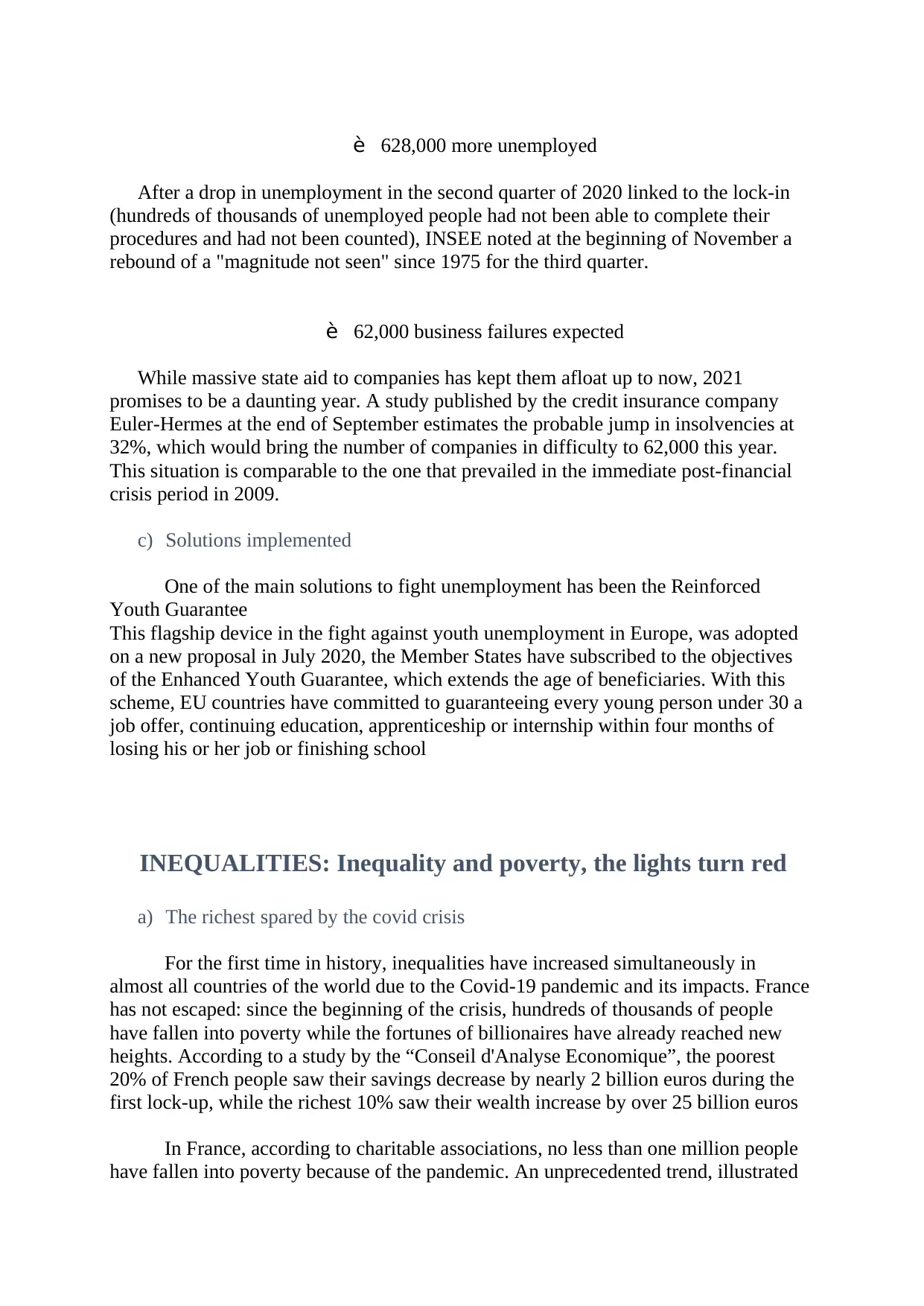
è 628,000 more unemployed
After a drop in unemployment in the second quarter of 2020 linked to the lock-in
(hundreds of thousands of unemployed people had not been able to complete their
procedures and had not been counted), INSEE noted at the beginning of November a
rebound of a "magnitude not seen" since 1975 for the third quarter.
è 62,000 business failures expected
While massive state aid to companies has kept them afloat up to now, 2021
promises to be a daunting year. A study published by the credit insurance company
Euler-Hermes at the end of September estimates the probable jump in insolvencies at
32%, which would bring the number of companies in difficulty to 62,000 this year.
This situation is comparable to the one that prevailed in the immediate post-financial
crisis period in 2009.
c) Solutions implemented
One of the main solutions to fight unemployment has been the Reinforced
Youth Guarantee
This flagship device in the fight against youth unemployment in Europe, was adopted
on a new proposal in July 2020, the Member States have subscribed to the objectives
of the Enhanced Youth Guarantee, which extends the age of beneficiaries. With this
scheme, EU countries have committed to guaranteeing every young person under 30 a
job offer, continuing education, apprenticeship or internship within four months of
losing his or her job or finishing school
INEQUALITIES: Inequality and poverty, the lights turn red
a) The richest spared by the covid crisis
For the first time in history, inequalities have increased simultaneously in
almost all countries of the world due to the Covid-19 pandemic and its impacts. France
has not escaped: since the beginning of the crisis, hundreds of thousands of people
have fallen into poverty while the fortunes of billionaires have already reached new
heights. According to a study by the “Conseil d'Analyse Economique”, the poorest
20% of French people saw their savings decrease by nearly 2 billion euros during the
first lock-up, while the richest 10% saw their wealth increase by over 25 billion euros
In France, according to charitable associations, no less than one million people
have fallen into poverty because of the pandemic. An unprecedented trend, illustrated
After a drop in unemployment in the second quarter of 2020 linked to the lock-in
(hundreds of thousands of unemployed people had not been able to complete their
procedures and had not been counted), INSEE noted at the beginning of November a
rebound of a "magnitude not seen" since 1975 for the third quarter.
è 62,000 business failures expected
While massive state aid to companies has kept them afloat up to now, 2021
promises to be a daunting year. A study published by the credit insurance company
Euler-Hermes at the end of September estimates the probable jump in insolvencies at
32%, which would bring the number of companies in difficulty to 62,000 this year.
This situation is comparable to the one that prevailed in the immediate post-financial
crisis period in 2009.
c) Solutions implemented
One of the main solutions to fight unemployment has been the Reinforced
Youth Guarantee
This flagship device in the fight against youth unemployment in Europe, was adopted
on a new proposal in July 2020, the Member States have subscribed to the objectives
of the Enhanced Youth Guarantee, which extends the age of beneficiaries. With this
scheme, EU countries have committed to guaranteeing every young person under 30 a
job offer, continuing education, apprenticeship or internship within four months of
losing his or her job or finishing school
INEQUALITIES: Inequality and poverty, the lights turn red
a) The richest spared by the covid crisis
For the first time in history, inequalities have increased simultaneously in
almost all countries of the world due to the Covid-19 pandemic and its impacts. France
has not escaped: since the beginning of the crisis, hundreds of thousands of people
have fallen into poverty while the fortunes of billionaires have already reached new
heights. According to a study by the “Conseil d'Analyse Economique”, the poorest
20% of French people saw their savings decrease by nearly 2 billion euros during the
first lock-up, while the richest 10% saw their wealth increase by over 25 billion euros
In France, according to charitable associations, no less than one million people
have fallen into poverty because of the pandemic. An unprecedented trend, illustrated
Paraphrase This Document
Need a fresh take? Get an instant paraphrase of this document with our AI Paraphraser
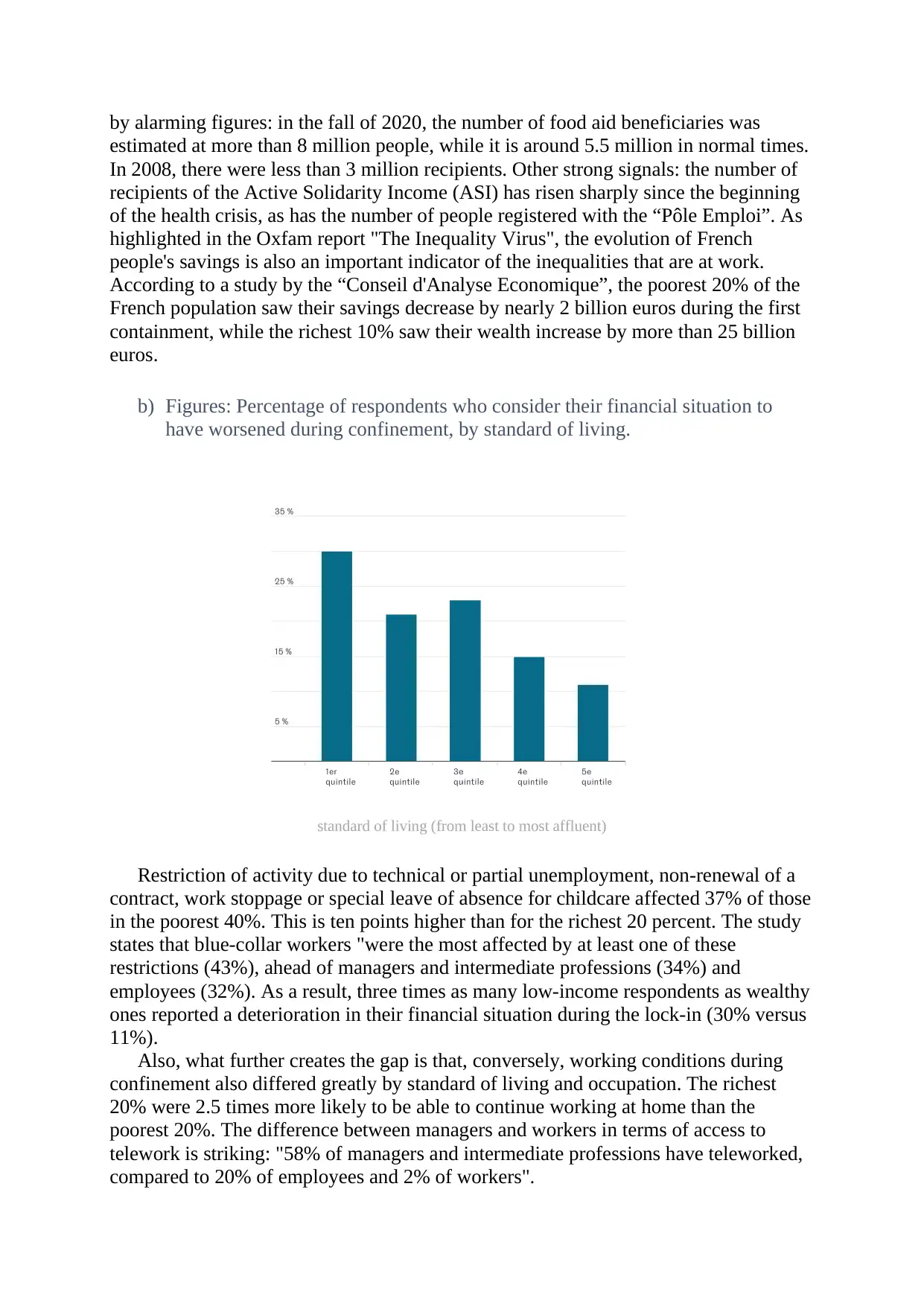
by alarming figures: in the fall of 2020, the number of food aid beneficiaries was
estimated at more than 8 million people, while it is around 5.5 million in normal times.
In 2008, there were less than 3 million recipients. Other strong signals: the number of
recipients of the Active Solidarity Income (ASI) has risen sharply since the beginning
of the health crisis, as has the number of people registered with the “Pôle Emploi”. As
highlighted in the Oxfam report "The Inequality Virus", the evolution of French
people's savings is also an important indicator of the inequalities that are at work.
According to a study by the “Conseil d'Analyse Economique”, the poorest 20% of the
French population saw their savings decrease by nearly 2 billion euros during the first
containment, while the richest 10% saw their wealth increase by more than 25 billion
euros.
b) Figures: Percentage of respondents who consider their financial situation to
have worsened during confinement, by standard of living.
standard of living (from least to most affluent)
Restriction of activity due to technical or partial unemployment, non-renewal of a
contract, work stoppage or special leave of absence for childcare affected 37% of those
in the poorest 40%. This is ten points higher than for the richest 20 percent. The study
states that blue-collar workers "were the most affected by at least one of these
restrictions (43%), ahead of managers and intermediate professions (34%) and
employees (32%). As a result, three times as many low-income respondents as wealthy
ones reported a deterioration in their financial situation during the lock-in (30% versus
11%).
Also, what further creates the gap is that, conversely, working conditions during
confinement also differed greatly by standard of living and occupation. The richest
20% were 2.5 times more likely to be able to continue working at home than the
poorest 20%. The difference between managers and workers in terms of access to
telework is striking: "58% of managers and intermediate professions have teleworked,
compared to 20% of employees and 2% of workers".
estimated at more than 8 million people, while it is around 5.5 million in normal times.
In 2008, there were less than 3 million recipients. Other strong signals: the number of
recipients of the Active Solidarity Income (ASI) has risen sharply since the beginning
of the health crisis, as has the number of people registered with the “Pôle Emploi”. As
highlighted in the Oxfam report "The Inequality Virus", the evolution of French
people's savings is also an important indicator of the inequalities that are at work.
According to a study by the “Conseil d'Analyse Economique”, the poorest 20% of the
French population saw their savings decrease by nearly 2 billion euros during the first
containment, while the richest 10% saw their wealth increase by more than 25 billion
euros.
b) Figures: Percentage of respondents who consider their financial situation to
have worsened during confinement, by standard of living.
standard of living (from least to most affluent)
Restriction of activity due to technical or partial unemployment, non-renewal of a
contract, work stoppage or special leave of absence for childcare affected 37% of those
in the poorest 40%. This is ten points higher than for the richest 20 percent. The study
states that blue-collar workers "were the most affected by at least one of these
restrictions (43%), ahead of managers and intermediate professions (34%) and
employees (32%). As a result, three times as many low-income respondents as wealthy
ones reported a deterioration in their financial situation during the lock-in (30% versus
11%).
Also, what further creates the gap is that, conversely, working conditions during
confinement also differed greatly by standard of living and occupation. The richest
20% were 2.5 times more likely to be able to continue working at home than the
poorest 20%. The difference between managers and workers in terms of access to
telework is striking: "58% of managers and intermediate professions have teleworked,
compared to 20% of employees and 2% of workers".
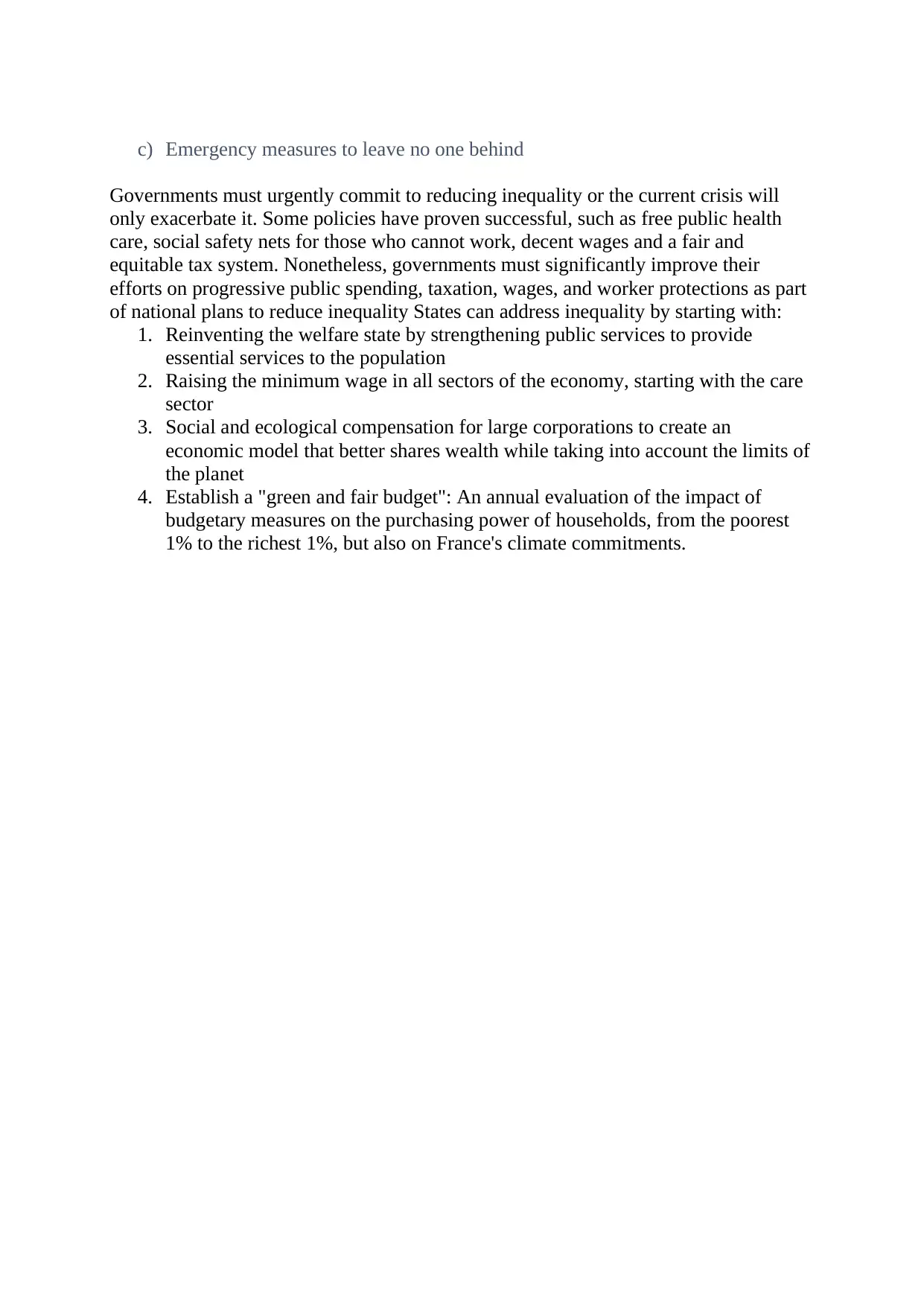
c) Emergency measures to leave no one behind
Governments must urgently commit to reducing inequality or the current crisis will
only exacerbate it. Some policies have proven successful, such as free public health
care, social safety nets for those who cannot work, decent wages and a fair and
equitable tax system. Nonetheless, governments must significantly improve their
efforts on progressive public spending, taxation, wages, and worker protections as part
of national plans to reduce inequality States can address inequality by starting with:
1. Reinventing the welfare state by strengthening public services to provide
essential services to the population
2. Raising the minimum wage in all sectors of the economy, starting with the care
sector
3. Social and ecological compensation for large corporations to create an
economic model that better shares wealth while taking into account the limits of
the planet
4. Establish a "green and fair budget": An annual evaluation of the impact of
budgetary measures on the purchasing power of households, from the poorest
1% to the richest 1%, but also on France's climate commitments.
Governments must urgently commit to reducing inequality or the current crisis will
only exacerbate it. Some policies have proven successful, such as free public health
care, social safety nets for those who cannot work, decent wages and a fair and
equitable tax system. Nonetheless, governments must significantly improve their
efforts on progressive public spending, taxation, wages, and worker protections as part
of national plans to reduce inequality States can address inequality by starting with:
1. Reinventing the welfare state by strengthening public services to provide
essential services to the population
2. Raising the minimum wage in all sectors of the economy, starting with the care
sector
3. Social and ecological compensation for large corporations to create an
economic model that better shares wealth while taking into account the limits of
the planet
4. Establish a "green and fair budget": An annual evaluation of the impact of
budgetary measures on the purchasing power of households, from the poorest
1% to the richest 1%, but also on France's climate commitments.
⊘ This is a preview!⊘
Do you want full access?
Subscribe today to unlock all pages.

Trusted by 1+ million students worldwide
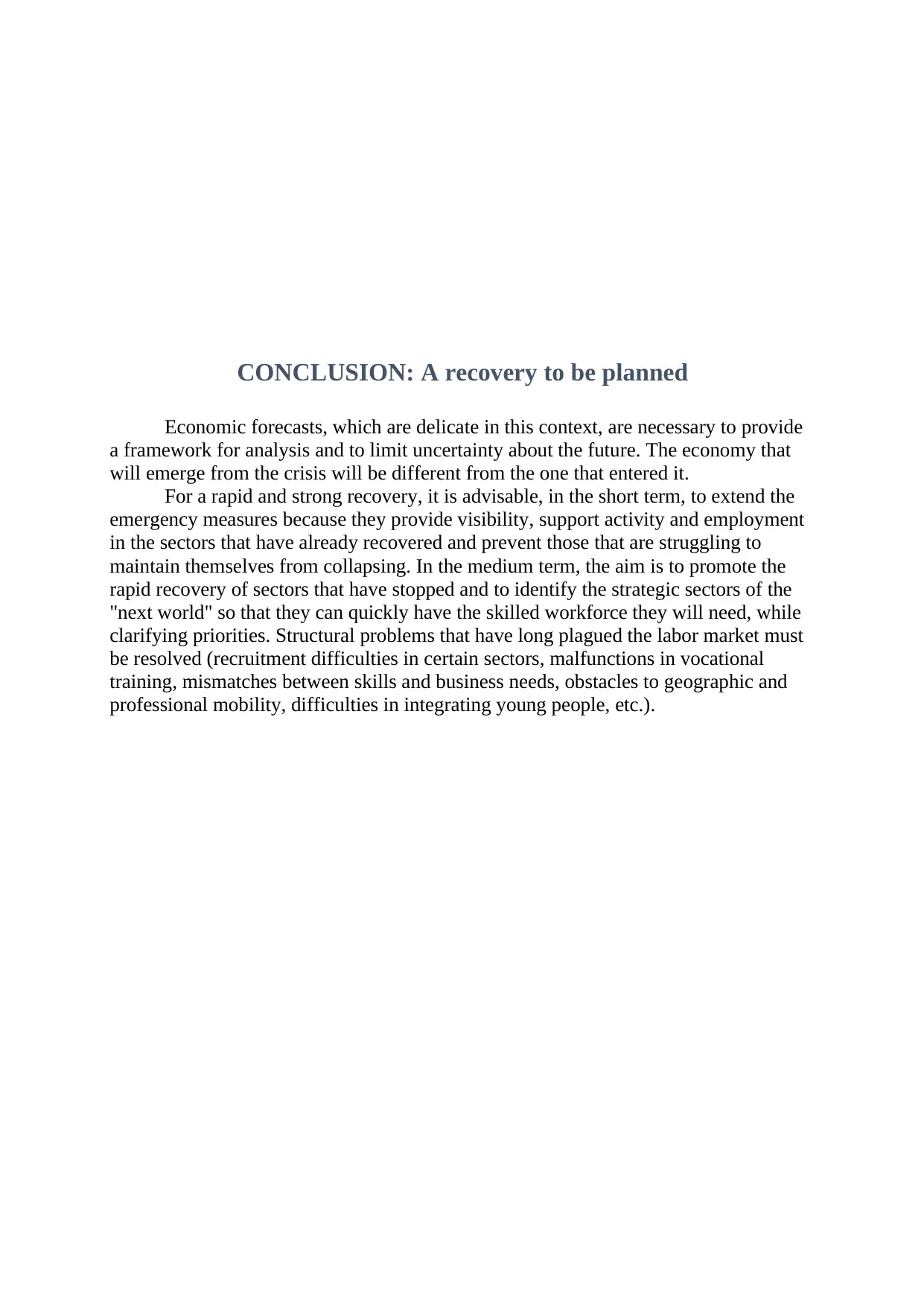
CONCLUSION: A recovery to be planned
Economic forecasts, which are delicate in this context, are necessary to provide
a framework for analysis and to limit uncertainty about the future. The economy that
will emerge from the crisis will be different from the one that entered it.
For a rapid and strong recovery, it is advisable, in the short term, to extend the
emergency measures because they provide visibility, support activity and employment
in the sectors that have already recovered and prevent those that are struggling to
maintain themselves from collapsing. In the medium term, the aim is to promote the
rapid recovery of sectors that have stopped and to identify the strategic sectors of the
"next world" so that they can quickly have the skilled workforce they will need, while
clarifying priorities. Structural problems that have long plagued the labor market must
be resolved (recruitment difficulties in certain sectors, malfunctions in vocational
training, mismatches between skills and business needs, obstacles to geographic and
professional mobility, difficulties in integrating young people, etc.).
Economic forecasts, which are delicate in this context, are necessary to provide
a framework for analysis and to limit uncertainty about the future. The economy that
will emerge from the crisis will be different from the one that entered it.
For a rapid and strong recovery, it is advisable, in the short term, to extend the
emergency measures because they provide visibility, support activity and employment
in the sectors that have already recovered and prevent those that are struggling to
maintain themselves from collapsing. In the medium term, the aim is to promote the
rapid recovery of sectors that have stopped and to identify the strategic sectors of the
"next world" so that they can quickly have the skilled workforce they will need, while
clarifying priorities. Structural problems that have long plagued the labor market must
be resolved (recruitment difficulties in certain sectors, malfunctions in vocational
training, mismatches between skills and business needs, obstacles to geographic and
professional mobility, difficulties in integrating young people, etc.).
Paraphrase This Document
Need a fresh take? Get an instant paraphrase of this document with our AI Paraphraser

REFERENCES
https://sdw.ecb.europa.eu/servlet/desis?node=1000004962
https://www.allianz.com/content/dam/onemarketing/azcom/Allianz_com/economic-
research/publications/specials/en/2020/december/2020_12_02_FrenchConsumption.pd
f
https://www.statista.com/statistics/1147699/evolution-unemployment-coronavirus-
france/
https://www.ceicdata.com/en/indicator/france/trade-balance
https://www.cae-eco.fr/staticfiles/pdf/cae-focus049-cb-en.pdf
https://www.diplomatie.gouv.fr/en/french-foreign-policy/economic-diplomacy-
foreign-trade/news/article/foreign-trade-results-in-the-first-half-of-2020-07-aug-20
https://link.springer.com/article/10.1007/s10198-020-01254-0
https://www.mfat.govt.nz/en/trade/mfat-market-reports/market-reports-europe/france-
trade-and-economic-update-26-february-2021/
https://sdw.ecb.europa.eu/servlet/desis?node=1000004962
https://www.allianz.com/content/dam/onemarketing/azcom/Allianz_com/economic-
research/publications/specials/en/2020/december/2020_12_02_FrenchConsumption.pd
f
https://www.statista.com/statistics/1147699/evolution-unemployment-coronavirus-
france/
https://www.ceicdata.com/en/indicator/france/trade-balance
https://www.cae-eco.fr/staticfiles/pdf/cae-focus049-cb-en.pdf
https://www.diplomatie.gouv.fr/en/french-foreign-policy/economic-diplomacy-
foreign-trade/news/article/foreign-trade-results-in-the-first-half-of-2020-07-aug-20
https://link.springer.com/article/10.1007/s10198-020-01254-0
https://www.mfat.govt.nz/en/trade/mfat-market-reports/market-reports-europe/france-
trade-and-economic-update-26-february-2021/
1 out of 11
Your All-in-One AI-Powered Toolkit for Academic Success.
+13062052269
info@desklib.com
Available 24*7 on WhatsApp / Email
![[object Object]](/_next/static/media/star-bottom.7253800d.svg)
Unlock your academic potential
© 2024 | Zucol Services PVT LTD | All rights reserved.
